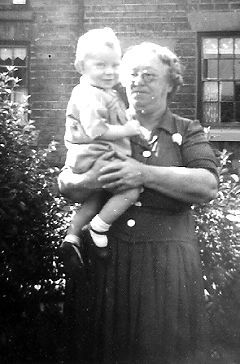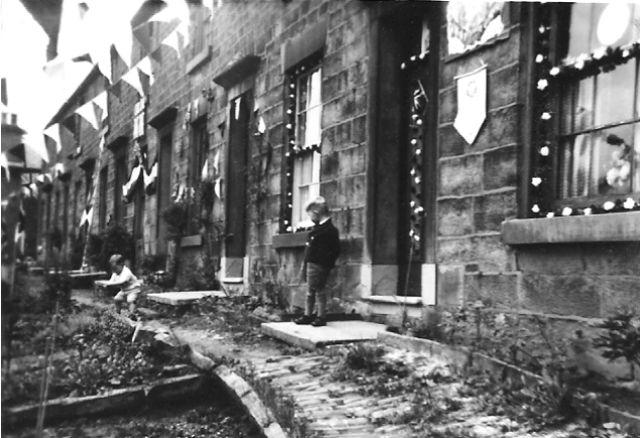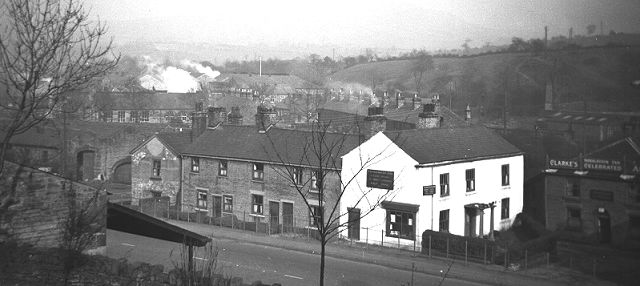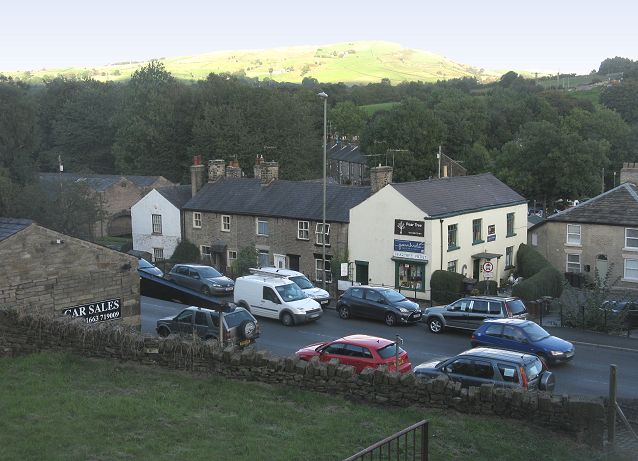Written by Charlie Hulme

Rachel Middleton was born Rachel Downs in 1887 in a house on Market Terrace in New Mills, a town three miles from Whaley Bridge, to John Goodwin Downs and his wife Emily, and by the age of 14 was working as a winder in a local cotton mill.
By 1911 the family - John, Emily, Rachel and younger sister Sarah Elizabeth, had moved to Canal Street, Whaley Bridge, where John described himself as ' Stone Hewer - Quarryman'. Rachel was still working, and Sarah Elizabeth (aged 22) is described by her father in the 1911 census record as 'Winder in Cotton Mill, sick at home'.
Sarah Elizabeth Downs was working as a dressmaker when she married George Peter Bagshaw in 1913. The family later moved to Chorley, Lancashire, and when Sarah died in 1968 their sons living there became Rachel's closest relatives.
Street numbering in Canal Street is confusing for historians. Houses were numbered in the traditional way with 'evens' on one side and 'odds' on the other, but in both cases it was only physically possible to build on the 'odd' side, and at some time (1920s?) this was recognised and the houses were renumbered in a consecutive series. The situation in Canal Street is further complicated because the present No. 11 was at some time part of the adjacent white house, Pear Tree Cottage.
John Goodwin Downs described his house in 1911 as no. 16 Canal Street, but oddly the Enumerator on his 1911 summary sheet called it no.21. It was a small house with just four rooms, possibly the one now know as No.13.
In 1915 Rachel Downs married Henry Fawcett Middleton, who in 1911 was working as a printworks labourer living with his father William Middleton in Grove House, Furness Vale, a village between Whaley Bridge and New Mills. William Middleton was described as 'Gentleman living on own means' - in earlier years he had been the farmer at Diglee Farm, and before that a grocer.
Pear Tree Cottage, the large white house - now no. 10 Canal Street - was for many years the home of Joshua Rhodes, whose mineral water manufactory occupied buildings behind the house, and obtained its water from a well in the cellar of the house.
Pear Tree Mineral Water Works
I have always known that the buildings behind our houses at 11 Canal Street had been at one time operated as a mineral water factory by a Joshua Rhodes, but I knew little more than that until I began research for this article, and I came across some information in the blog of the Furness Vale Local History Society, which I reproduce here by permission:
'William Morten, one time landlord of the Dog and Partridge had established his mineral water business in Whaley Bridge by 1856. His first premises were at Rosen Bank above the Cock Hotel, later Jodrell Arms. Building of the railway required his re-location to Pear Tree Cottage in Canal Street. In 1889 he bought the property from the executors of its previous owner, John Vaux, together with Vaux’s Row, later Johnson Street and the Navigation Inn. The business was taken over in 1895 by Joshua Rhodes, a previous partner. Mineral waters continued to be manufactured until the business was sold in 1918 to John William Grundy who transferred production to his Stockport site.
'Joshua Rhodes also had a carriage hire business and operated in 1901, the first local bus service between Whaley Bridge and New Mills.'
The Pear Tree property remained in the Grundy family after 1918, and may have seen some continued use; my father (born 1910) remembered the place well. The local children would get hold of the empty bottles, which had a glass ball inside as a seal, and break them to provide equipment for the game of 'marbles'.
Apparently in its later days the Pear Tree plant's output included more than just soft drinks, having obtained a licence to bottle beer. The water supply for the works came from a source in the cellar of Pear Tree Cottage, which seems to have been connected to the well at the original location across the road. The source was reached by a mysterious door down a flight of steps in the back yard, which I was never allowed to enter.
In 1926, John Goodwin Downs, by then a quarry manager, bought the works, Pear Tree Cottage and the adjacent cottages from Grundy's widow, and moved his family into the larger house. Perhaps it was at this time that No.11 became a separate home.
John Goodwin Downs died in 1927; his widow Emily lived until 1943. John Goodwin Downs, Emily Downs, Henry Fawcett Middleton and Mary Middleton are buried in a family grave in St Georges Road Methodist graveyard in New Mills.
Henry Fawcett Middleton (known as Harry) died on 13 April 1937 aged only 52, and tragically their only child Mary, Mary Middleton, died in 1940 aged only 23, after choking on a fish bone. Rachel lived alone in Pear Tree Cottage for many years afterwards; she died in 1969, aged 82.

The Spring Bank area, from an old photograph. No.5 (formerly No.8) is at the top of the long flight of steps. The house in the centre was the home and surgery of two generations of local General Practitioners Drs. Allan. Source: Whaley Bridge photos website.
Rachel's father, her father-in-law and her husband appear to invested their savings in property, with the result that Mrs Middleton came to own a number of terraced houses in the Whaley Bridge area, including No.5 Reservoir Road, part of Spring Bank Terrace, which was rented by my grandfather Albert Hulme and his family. This end house, part of a terrace built c.1853, had been purchased in 1934 by Henry Fawcett Middleton.

Spring Bank Terrace decorated for the Coronation in 1953. That's me nearest the camera.
By the time my mother, Agnes Hill, married Albert's son Charles Hulme in 1948, the little house was home to Charles, his sisters Marion and Beatrice, and Beatrice's daughter. After the wedding, my mother moved in as well, but when I was born Mrs Middleton found another of her houses, No.12 Canal Street, for us to live in at a very reasonable rent. Having lost her own daughter, she took a great interest in my welfare, and became known to me as my 'Aunty Middleton.' A few years later, the larger cottage next door at No. 11 Canal Street became vacant, and we moved in for a reasonable weekly rent of 12 shillings, at a time when my father was working as a labourer for eight pounds per week. On top of this we had a few shillings to pay in Rates which went to the council. This rent remained more or less unchanged until I bought the house in 1976. No. 11 (along with adjacent Pear Tree Cottage), had gained a two-storey extension, on a slightly lower level, added at some time, which comprised our kitchen and my bedroom. also had an bathroom inside toilet, whereas No. 12 at that time had a toilet (a proper water closet) in an outhouse, and baths involved the legendary 'tin bath.'
Behind our houses was a yard, formerly part of the mineral water factory (see left-hand column) which was my personal playground, a place to hang washing, and in our early days a place where the 'dolly tub' and mangle were brought into use on washing day. The yard had, I believe, been roofed over at some time, and part of the roofed area remained with its wooden doors. Beyond, between us at the builder's yard of Samuel Drinkwater & Son, was a two storey stone building with abandoned rooms on both levels, where by kind permission of Mrs Middleton, my father created a workshop in which he engaged in his hobby of woodworking, and built several items of furniture for us. We also had room to store our coal there in the ground floor room, which also a contained a considerable quantity of assorted junk. A room upstairs was used for 'keep-fit classes' for a while. This building was clearly of the same period as the houses, and possibly acted as office and store for the mineral water bottler. William Taylor, who first leased the land in 1814, was a timber merchant; these buildings would have formed part of his timber yard.

Canal Street, c.1950, Pear Tree Cottage is the white building, with No.11 to the left, then nos. 12, 13 and the canal house. The Navigation Inn on the right. Picture by Agnes Hulme.
Our back door was a short walk from that of Pear Tree Cottage, and from my childhood I recall are of her walking uninvited into our house for a 'chat' on a regular basis. It seemed irritating at the time, but of course she was very lonely in the big house and was really very kind to us. Sometimes I would run errands for her and help with things - in her last years she became very confused and struggled to cook for herself; looking back I know that I should have been more grateful to her, and to a number of other Whaley Bridge residents who helped our little family along the way.

Canal Street, 2016, with the former A6 road in the foreground strewn with cars. The Navigation Inn has become just another 'lost pub.' The curious carved stone heads, of unknown provenance, which sat above the porch of Pear Tree Cottage, mysteriously disappeared at some time, possibly in the 1970s.
After Mrs Middleton died, Pear Tree Cottage was for a while the home of Fred Branson, retired landlord of the nearby Goyt Inn, and his wife Jessie, before eventually becoming a café as it remains in 2016. The shop front on the Canal Street side of the building, has had various uses; I'm told that it from 1861 it was used for a short period by the Whaley Bridge Co-Operative Society. Nearer to my time it was, I believe, run as a haberdashery by a former resident of No.11. What I recall from the 50s and 60s is a 'showroom' for Drinkwater's builders whose yard was nearby, with an uninspiring window display of plumbing fittings. More recently it became a craft shop, founded by Peter Cordey (the conductor of Whaley Brass Band) which morphed into 'Pear Tree Print', still flourishing under different management in 2016. Peter kindly kept an eye on my mother's welfare after I moved away, for which I'll always be grateful.
I bought 11 Canal Street in 1976 from George and John Bagshaw of Chorley, legatees of Sarah Elizabeth Downs, although we still paid 'ground rent' annually to the successors of the Jodrell estate; our share of the rent specified in the original lease, which was for the whole plot of land including the Navigation Inn, our row of cottages, and another row in Johnson Street, was apportioned from the 1814 sum for the whole plot of £11.6s.3d., at £2 per annum, which I believe still applies in 2016. Ancient leases such as this made no provision for inflation.
I married in 1985 and moved to Stockport; my mother remained in no.11 Canal Street until her death in 2002 aged 90. The house was sold in 2003 to a property developer, and has been rebuilt internally to a less eccentric layout, without the two 'cupboards' which were actually sealed-off doorways to Pear Tree Cottage and the shop. The downstairs bathroom, which was partly under the stairs of No.12, has been replaced by a more conventional one. Another oddity was that the roof on the street side was slate, but at the rear the original stone flagged roofing was still in place. The single living room featured a very deep oak beam, supporting the room above, which had been wallpapered over.
No.5 Reservoir Road also remained with my father's family for many years, surviving a traumatic lightning strike in the 1950s. Marion Hulme left in 1953 on her marriage to local postman Walter Lamb, while Beatrice and her daughter Ivy, her husband John and son Nigel were the last residents from our family. Sold in 2015, the house was noted in 2016 undergoing a complete rebuild.

The map above shows Whaley Bridge, c. 1900, showing in red Pear Tree Cottage (upper) and No.5 Spring Bank Terrace. The bridge over the river around which the village developed can be seen. At that time, and until boundary changes in 1936 when it was incorporated into Derbyshire to join the rest of the village, this part of Whaley Bridge west of the original course of the River Goyt (shown on the map), was in Cheshire, part of the township of Yeardsley-cum-Whaley. The boundary markings deviate from the river towards the top right-hand corner of the extract, because the river was diverted when Goyt Mill was built in 1865.
Thanks
David Easton of the Furness Vale Local History Society has very kindly supplied me with much information about the complex history of Pear Tree Cottage, the mineral water firm. This really deserves an article of its own; a project for the future, perhaps.
Written by Charlie Hulme, October 2016. Updated October 2017.
Comments welcome: charlie@davenportstation.org.uk